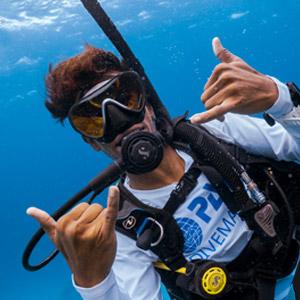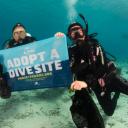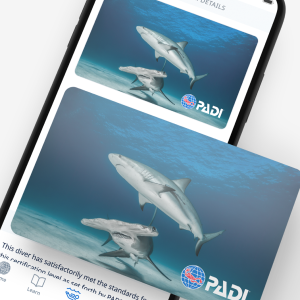Publishing a Top 10 list is always risky, especially when it comes to listing the wealth of adventures a diver can have in a country like Belize. It may be one of the smallest nations in Central America, but it's home to the world's second-longest barrier reef and three of only four true coral atolls in the western hemisphere. During the spring and early summer months, Belize is one of the most reliable destinations for swimming with whale sharks, and it boasts the most recognizable landmark in the known dive world, the massive ocean cavern known simply as the Blue Hole.
Now factor in the topside attractions-some of the most significant Mayan archaeological sites in all of Central America, laid-back beach towns, remote island dive lodges, and adventurous jungle tours. Ten doesn't even begin to cover all the reasons thousands of divers flock to Belize every year.
So Belize veterans, let us state up front that there will likely be differences of opinion, maybe even a few glaring omissions compared to your own list-and that we should get together soon over a cold Belikin or three and hash them out.
1. Hol Chan Marine Reserve
Hol Chan is Mayan for "Little Channel" and refers to the deep cut in the barrier reef off Ambergris Caye (See #3 on this list). It's the access point to dive sites outside the barrier reef, and the center of the three-square-mile Hol Chan Marine Reserve. In place since 1987, the park is actively patrolled to enforce the rules: no anchoring, no touching the coral, and no fishing. The aggressive protection has paid off in the form of abundant marine life and healthy stands of elkhorn coral - a rare treat. Though only about 30 feet/9 meters deep, the cut is a must-see dive. The current can be blistering, but hanging out with the dense schools of jacks, grouper, snapper and barracuda massed along the walls is worth it.
2. Shark Ray Alley
Leave the tank behind and bring your snorkel for the most famous site in the reserve, Shark Ray Alley. This shallow sand plateau inside the barrier reef was once the place where fishermen would clean their catches. All the discarded chum naturally attracted swarms of nurse sharks and squadrons of stingrays. Today, dive guides dole out fish scraps to lure in the sharks, rays (and anything else that happens to be swimming by) so you can get the close-up photos of a lifetime.
3. Ambergris Caye/San Pedro
In a country filled with exceptional dive options, Ambergris Caye is the most popular spot for three simple reasons - location, location, location. The largest of 200 cayes that dot the coastline, it's just a 20-minute plane ride from Belize City. It's also the closest you can get to the Belize barrier reef. From any of the dockside dive shops you're never more than a few minutes by boat to a great dive on the deep spur-and-groove coral formations that shelter the island, or to the Hol Chan Marine Reserve. Topside, San Pedro is one of those quirky, laid-back beach towns that divers take to instantly. Thanks to a just-right mix of waterfront restaurants, bars, internet cafes, ATMs, and small stores, you have all the conveniences of home while still reveling in that world-away feeling. Golf carts are the preferred mode of transportation, and some of your favorite establishments still have sand floors and a shoes-optional dress code.
4. The Barrier Reef
The Belize barrier reef, the largest in the western hemisphere, stretches north to south along all 190 miles of the coastline, sheltering the interior cayes and providing divers with countless opportunities to explore. The reef runs closest to shore near Ambergris, slowly arcing away as it heads south. Dive operators from the cayes and Belize City specialize in taking divers through the deep coral canyons built by staghorn, elkhorn and brain corals. Many dive sites start in as little as 45 feet/14 meters of water, but they can drop to 90 feet/27 meters or more. Marine life includes all the usual Caribbean reef fish suspects, from tiny tropicals to reef sharks and turtles. The barrier reef is also home to the whitespotted toadfish, a species found only in Belize. It likes hiding in reef crevices and is easy to miss if you don't know where to look, but dive guides here are adept at finding them. They even have a special hand signal for it - fingers wiggling under the chin-in imitation of the fleshy growths on the toadfish's face.
5. The Dolphin Encounter
Belize's first dolphin encounter is now operating at a custom facility on Spanish Lookout Caye, located just a short ride from Belize City. Hugh Parkey's Belize Dolphin Experience takes place in a natural four-acre lagoon and is more than the usual watch-Flipper-do-tricks show. "It's natural behaviors that we put on display," says Aggie Obama, director of marine mammals. In addition to learning about the habitat and natural history of dolphins, guests also get hands-on interaction with an educational twist - feeling the dolphin's heartbeat, learning how the trainers and staff monitor the health of the animals, and how they keep the curious cetaceans mentally stimulated.
6. The Blue Hole
If the sight of this massive ocean cavern doesn't quicken your pulse, surrender your C-card at once. The signature dive of Belize is more than 1,000 feet/300 meters across, almost perfectly round, and that deep blue orb is a tantalizing 450 feet/137 meters deep. It's centrally located and within reach of fast boats from any of the cayes, Belize City, the atolls and coastal resorts as far south as Hopkins. For many divers, the Blue Hole is the highlight of a week's stay, but it's a deep dive so be prepared. Here's the drill: Following your guide, you immediately descend to 130 feet/40 meters, where you have just eight minutes to marvel at a row of stalactites suspended from the cavern ceiling, some three feet/one meter in diameter. When your no-deco time is almost over, you'll work your way up the wall to about 50 feet/15 meters, often in the company of reef and bull sharks. And if you want to really make your buddies back home jealous, make time for a helicopter fly-over.
7. The Atolls
Outside the barrier reef, you'll find three of the four true coral atolls found in the Western Hemisphere-Turneffe, Lighthouse and Glover's. Think of them as circular barrier reefs wrapped around conveniently placed sandbars that have just enough dry area for a comfortable dive lodge or two. Looking for a quiet place to get away from it all? You just found three of them. The fringing reefs drop off to depths of more than 3,000 feet/914 meters, and offer everything from shallow coral gardens to vertical walls and towering coral pinnacles riddled with canyons and swim-throughs. Turneffe is the largest of the three atolls, and closest to the mainland. A fast boat can have you here from the mainland in less than an hour. Most diving takes place around the atoll's southern tip and the signature dive is a dramatic twist in the reef called the Elbow. Lighthouse Reef is the farthest from the mainland and encircles a 30-mile/48-kilometerlong lagoon that includes the famous Blue Hole. Glover's Reef is the most remote and least visited atoll, but it offers more than 50 miles/80 kilometers of fringing reef. The interior cayes of the atoll are home to small lodges, but Glover's can also be reached by day boats from Hopkins (See #8 on this list).
8. The Southern Coast
Belize has a growing roster of dive options, as new resorts and operators open along the southern coastline, staking their claim to the southern barrier reef. Some of the newest resorts are popping up in and around the southern coastal town of Hopkins, which is also conveniently within fast boat range of Glover's Reef, the Blue Hole and Gladden Spit. Farther south, Placencia is home to some of the country's best beaches, but is now better known as the closest jumping-off point for whale shark encounters at Gladden Spit and the Silk Cayes.
9. Whale Sharks
Another "big" attraction for divers is the lumbering whale shark. Encounters are virtually guaranteed from April to June at a portion of the southern barrier reef known as Gladden Spit, and recently, scientists figured out why. The migration of whale sharks through the area coincides with the spawning cycle of 25 different species of fish. Whale sharks are plankton eaters, so all the eggs released during spawning-particularly the larger eggs of the cubera snapper-are an easy and abundant food source. During this time, the well-fed and docile whale sharks are often willing to approach boats and divers, and will stick around posing for pictures if you follow the rules of the marine park and avoid harassing the animals. If you've never had the privilege of swimming up close to the biggest fish in the sea, a visit to Gladden Spit during the season is a must.
10. Topside Tours
Belize is rare among top dive destinations in that it offers as many topside attractions as it does great dives. The convenient geography of the country - it's only about the size of Massachusetts - means that from almost anywhere on the mainlaind you can venture out on a topside tour and be back at your resort in time for cocktails. Some of the most accessible Mayan archaeological sites in all of Central America are found in Belize, and should not be missed. Favorites include Xunatunich, an ancient ceremonial center overlooking the Mopan River valley near the Guatemala border; Altun Ha, just outside of Belize City; and Lamanai, a scarcely excavated site on the New River Lagoon. It's also worth adding a few days to your stay to visit an inland eco lodge. Ian Anderson's Caves Branch Jungle Lodge is a popular choice, offering a number of river, cave, and hiking tours.
In Depth
Water Conditions: Mid-70s in winter and low to mid-80s in summer. Wear at least a Lycra skin to ward off coral abrasions. Off Ambergris Caye, water clarity is variable, though generally decent. Visibility off the atolls is rarely bad, but it's best from April to June.
Weather: Tropical, which means pretty warm year-round. The coast, cayes, and atolls enjoy a brisk prevailing wind from the Caribbean, which moderates the heat.
Documents: Passport and proof of return is required.
Money Matters: The Belize dollar (BZ$) trades at BZ$2 to US$1 and BZ$2.25 to 1 euro. Credit cards and traveler's checks are accepted throughout the country. While Belize does not require a visa for entry, there is a $36.25 departure tax, payable in U.S. dollars only - no matter your home country
Time: The same as the Central Standard in the U.S. Daylight saving time is not observed.
Electricity: The same as in the U.S.-110 volts, 60 cycles-and the country uses the North American-style two-pin plug.
Dive Operators: For detailed information on Belize dive operators, comprehensive travel guides, special dive deals and recent trip reports submitted by users, go to our web site at www.scubadiving.com/travel/caribbeanatlantic/belize.
Tourism: Visit the web site of the Belize Tourism Board at www.travelbelize.org.
Start your adventure today.

 Technical Diving
Technical Diving
 ฟรีไดวิ่ง (Freediving)
ฟรีไดวิ่ง (Freediving)
 Emergency First Response
Emergency First Response
 ฟรี - ความรู้เบื้องต้นเกี่ยวกับการดำน้ำแบบออนไลน์
ฟรี - ความรู้เบื้องต้นเกี่ยวกับการดำน้ำแบบออนไลน์






 เศษซากทะเล
เศษซากทะเล
 ยพันธุ์ฉลามและกระเบนที่เสี่ยงต่อการสูญพันธ์ุ
ยพันธุ์ฉลามและกระเบนที่เสี่ยงต่อการสูญพันธ์ุ
 Adopt The Blue
Adopt The Blue


















